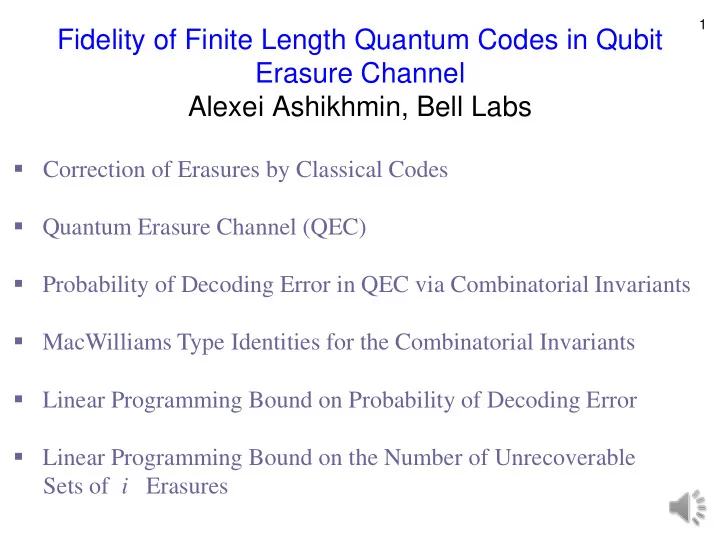

1 Fidelity of Finite Length Quantum Codes in Qubit Erasure Channel Alexei Ashikhmin, Bell Labs ▪ Correction of Erasures by Classical Codes ▪ Quantum Erasure Channel (QEC) ▪ Probability of Decoding Error in QEC via Combinatorial Invariants ▪ MacWilliams Type Identities for the Combinatorial Invariants ▪ Linear Programming Bound on Probability of Decoding Error ▪ Linear Programming Bound on the Number of Unrecoverable Sets of i Erasures
2 Correction of Erasures by Classical Codes (1) Binary Erasure Channel 0 0 (erasure) 1 1
3 Correction of Erasures by Classical Codes (2) • Let be a generating matrix of an [n,k] linear code C • We transmit • Let erasures occur on positions so we get a vector of the form When we can recover erasures on • Let be the set of non-erasures • We can recover erasures on iff columns of G corresponding to non erased positions have full rank, i.e.,
4 Combinatorial Lower Bound on Probability of Decoding Error • In the best possible case we have that any k columns of G have rank k • In this case only if erasures are not recoverable • Thus we have the following simple, but tight, lower bound: Theorem 1 (known of course): • This simple bound leads to Gallager’s spherical packing bound on the error exponent:
5 Quantum Erasure Channel (QEC) (1) k inf. qubits n code qubits encoding Quantum Erasure Channel erased qubits • Erasure means that qubit is moved into state which is orthogonal to legitimate states and . Hence, can be detected: • Thus, we can identify the set of positions S of qubits erasures • Erasures occur with probability
6 Quantum Erasure Channel (QEC) (2) A standard way to characterize the performance of a quantum code Q: entangle k information qubits with k qubits of a reference system QEC 1 1 Encoder Decoder 2 k qubits in 2 k qubits in n n QEC maximally entangled a new state state , which depends on S Uhlmann's fidelity:
7 Quantum Erasure Channel (QEC) (3) • A set of erasures S is recoverable if Uhlmann's fidelity is 1, i.e., • We define the probability of decoding error by
8 Quantum Linear Stabilizer Codes • An [[ n, k ]] stabilizer code Q is a subspace of dimension in • Q is associated with a classical [n, (n+k)/2] code over • The code has the property that its dual code , i.e. Here is defined by , where is symplectic inner product and is defined by:
9 Probability of Decoding Error (1) An alternative way of defining recoverable erasures is more useful: 1. Code is a union of cosets of : Here denotes code a vector from code (coset ) coset coset 2. We transmit a codeword and get (symbols from S are erased) Theorem 2: S is recoverable iff belongs to exactly one coset • Note that it is not necessary to restore the codeword itself ; we need to identify only the coset
10 Combinatorial Characterization of (2) • For a vector and a set of positions S, the punctured vector is Example: If then • For a code we define punctured and shortened codes: and Theorem 3: belongs to exactly one code coset (and hence S is recoverable) iff • Motivated by the above observation we define the code invariants:
11 Combinatorial Characterization of (3) Theorem 4: The number of recoverable sets of erasures is equal to Equivalently, the number of unrecoverable sets is (of course ) Corollary 5:
12 Combinatorial Characterization of (4) Example 1. Let Q’ be the [[12, 6]] code from the table of the best known codes. Q’ can be defined by the parity check matrix of code • Using this matrix we can find that • Using these we find the number of unrecoverable sets of size i : • Note that is visibly smaller than which is the number of all 3-erasure sets
13 Combinatorial Characterization of (5) Example 1 (continued) Using we can compute for any
14 MacWilliams Type Identities • We define vector and matrix with where and defined recursively (see the paper) Theorem 6: Note that in
15 Lower Bounds on and (1) • First, we establish the relation between and Theorem 7: (1) where (2) • We define vector with • (1) and (2) show that any is a linear combination of -s and therefore (1) and (2) allow us to form the matrix so that • Since all we get the constraint:
16 Lower Bounds on and (2) • Now we can formulate the following linear programming problem (3) • Let me remind that • This shows that is a linear combination of -s and, therefore, we can form vector so that • Using this in (3) and solving the linear programming problem, we get a lower bound
17 Lower Bounds on and (3) • Similarly, we can define so that (4) where is the number of uncorrectable sets of i erasures, and obtain a lower bound on Example 2 Let n=12 and k=6 . 1. Solving the optimization problem (3) with defined in (4), we prove that any [[12,6]] code (nondegenerate or degenerate) has Let me remind that the [[12,6]] code Q’ (with the largest min. distance) has
18 Lower Bounds on and (4) Example 2 (continued) 2. Solving the optimization problem (3) with defined so that we find such that any [[12,6]] code (nondegenerate or degenerate) has 3. Previously known lower bound: M. Tomamichel, M. Berta, J. M. Renes, “Quantum Coding with Finite Resources ,” Nature Communications, 7 , 2016: 11419 the following lower bound was obtained (20) This bound is quite weak, as the figure on the next slide shows
19 Lower Bounds on and (5) Example 2 (continued) The exact for [[12,6]] code Q’, our new bound, and previously known bound (20)
20 Thank You for Your Attention
Recommend
More recommend